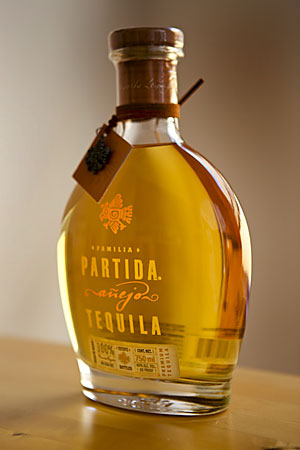In honor of “National Tequila Day”, we thought we would take a moment and talk about the process of actually tasting it. In our opinion, there are two ways to taste it: 1) the scary complicated way, and 2) our method, which is designed to be low-stress and high-fun.
You may have read tequila reviews on our site and thought about doing tastings at home and thought, “where do I start?” We admit we were intimidated by the potential complexity of tastings at first, given the amount of detailed charts, graphs and literature on the subject. Take, for instance, Ian Chadwick’s Tequila Tasting Wheel (adapted from the Wine Aroma Wheel) that lists over 100 flavor profiles, including “green olives”, “strawberry jam”, “soapy”, “fishy”, “ethanol”, and my personal favorite “wet wool/wet dog.”
I’ve tried a lot of tequilas at this point and I’ve never detected any of those flavors, but what do I know? In fact, Grover and I were talking about this last night and the only thing we’re certain we do know is if we think a tequila is good or not. So, we started thinking about what makes a tequila “good” or “not good” (in our humble opinions) and broke down our tasting notes to encompass the areas that we evaluate when making this decision.
This is what we came up with:
Nose or aroma — This gives you a first hint of what the tequila will taste like. Is it pungent, or subtle and sweet? Do you get a whiff of vanilla, or is it a blast of agave?
Taste — This should cover what the tequila tastes and feels like when it first hits your tongue. Is it smooth and caramely, or an explosion of alcohol? (Keep in mind that you should take an initial sip to get your palate used to the flavor before you really start determining the taste on the second sip.)
Finish — How does the flavor end at the back of your throat? Does it melt away in a continuation of the front, or does it go out in a spicy, long finish?
Finally, we take into account characteristics, such as if the tequila is smooth, sweet, or spicy, and its price point. Each person will have a different opinion on what they like, of course, so our job is simply to note the characteristics and let you decide for yourself.
The next time you taste something new at home, try writing down what you think of the nose, taste and finish, and any other characteristics that you think make it good or not good in your opinion. Hopefully, this will make for an informative and low-stress tasting!
Next up: Partida Añejo review using our non-patented tasting method!
-Scarlet




I couldn’t agree more with your way of low stress tequila tasting. Making it fun is the only way to go. I have put a lot of effort and research into learning all I can about quality Agave(I prefer blanco) but I can’t taste half of the flavors I hear experts describe, and wonder if maybe 3% of the population could actually taste “moist cement on a hot day”… I MEAN REALLY!!! I think I enjoy the tastings and comparisons more than if I just enjoyed the spirits. Learning what you like, and getting the main obvious smells and tastes is what’s most important. Keeping a list of brand descriptions is fun, as I may like a certain taste on a particular day, and it’s fun to see if my friends smell and taste the same flavors as I do. A new friend who is an expert, is giving me tips, and I like his ideas and have combined them to my “keep it simple” method. When I first started learning about quality tequila I started taking notes like, what does it smell like(nose),what does it taste like at first sip (initial taste) and how does it feel and taste as you swallow (finish). I always kept a rating of 1-5 on smoothness and one for overall taste. I figure I need an overall rating, of my feelings on the taste. I have 30-35 top quality blanco’s and love re-tasting them and adding flavors and smells to my notes on each, but I will probably never taste “wet daffodils” no matter how long I do this. You guys are great. Long Island Lou
From one Long Islander to another – Thanks Lou!
Really another Long islander..I sent you an email, I’m So excited to speak with you. Lou
Well when’s the last time you tasted a wet daffodil? And why would you do that? That’s just silly. It tastes how it tastes and that’s a subjective thing sometimes, but I wouldn’t imagine “wet daffodils” could taste very good. Maybe that’s an example of what people say about tequilas in a tasting, but I honestly wouldn’t be surprised if someone had actually tasted wet daffodils. Nothing is impossible. Those flavors are imperceptible to me too, so I get it.